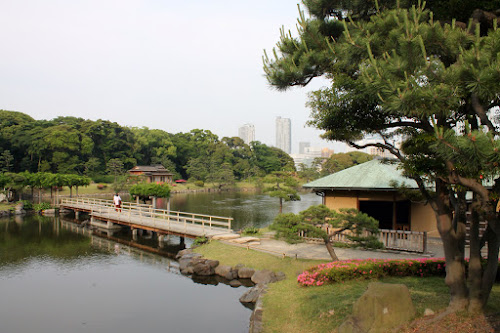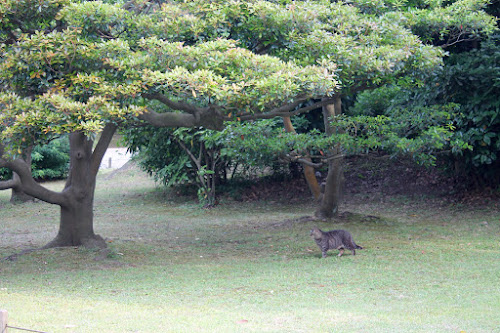Mein Ministadtführer aus dem Hotel meint, sehenswert wäre auch der Hamarikyū Garten, vom alten Bahnhof in Shimbashi nur 10 Minuten entfernt, außer es wird gebaut, dann sind es mal schnell 20 Minuten, aber hey, ich komme aus Berlin, Baustellen-Hindernis-Lauf? Bin ich die Beste drin. Und bevor ich mich auf den Weg nach Odaiba mache, gehe ich noch etwas Geschichte tanken und viele, viele Blumen ansehen.
Eintreffen am Kassenhäuschen, pampige Gewitterziege schnauzt mich am: 300 Yen. Nachdem sie mein Geld in ihrer Kasse versenkt hat, meint sie, wir schließen gleich. Charmant, charmant! Dauerlauf im Park? Bin ich dabei! Schmuckes Faltblatt kam mit der Eintrittskarte, das ist prima, nun weiß ich das sich hier einst ein historisches Irgendwas befunden hat, nun ist es hier grün. Es ist viel Grün, grünes Grün, satt und saftig und dazwischen Lilien am Wasser in weiß und violett.
Der Garten war erst gar keiner, sondern ein Jagdgebiet. Die Tokugawa Shogune gingen hier auf Entenjagd. 1654 bekam Tokugawa Tsunashige, der dritte Sohn von Tokugawa Iemitsu, der wiederum der 3. Shogun nach dem alten Ieyasu war, können mir alle folgen?....egal, er bekam 15.000 Tsubo, ca 50.000 m² von Tokugawa Ietsuna, das ist der 4. Shogun, geschenkt. Wer hat, dem wird gegeben. Tsunashige began mit der Landgewinnung, denn die Gegend war sumpfiges Schilfland und bis heute ist der Garten vom Festland durch einen Graben getrennt. Anfang des 18. Jahrhunderts wurde ganz groß umgebaut, zur ständigen Nutzung, es entstanden mehrere Teehäuser, das Haupttor und die Brücke. Kurze Zeit später, unter dem sechsten Shogun fand eine nochmalige Erweiterung statt. Wieder später, mittlerweile regierte der achte Shogun, wurde hier eine Schmiede und ein Pulvermagazin gebaut und statt Tee und Süßkram gab's Kanonen. 1727 verwüsteten Brände das ganze Gebiet und Anfang des nächsten Jahrhunderts, wir sind jetzt beim elften Shogun wurden wieder Teehäuser gebaut. Dann kam die Zwischenzeit, Bakumatsu, als die Edo-Zeit und das Shogunat langsam aber unausweichlich ihrem Ende entgegen gingen, wurde das Gebiet gar nicht mehr genutzt und 1866 erhielt der Marine-Kommissar hier seinen Sitz. Er sollte auch eine hübsche Residenz bekommen, aber die Arbeiter konnten gar nicht so schnell bauen, wie das Shogunat abgeschafft wurde und nun fiel das Gelände an den Hof und wurde der Hama-Außenposten, Hama-Rikyū. Von 1878 bis 1889 gab es hier ein Gästehaus aus Stein und westlicher Architektur, in dem 1879 der damaligen US-Präsident vom Meijikaiser mit Tee bewirtet wurde. Stelle mir gerade vor, wie der Kaiser dem Präsidenten Tee in einen Fingerhut einschenkt....
Das Kantobeben zerstörte das ganze Gebiet, also auch den Park und dann war in Japan anderes wichtiger als Gartenbau. Die Luftangriffe auf Tokyo 1944 und 1945 zerstörten, was noch da war und 1946 wurde der Garten der Stadt übertragen. Das war eine gute Idee. Er wurde nach historischem Vorbild wieder erstellt und ist heute Nationales Kulturgut und ein lebendiges Beispiel der Kultur der Edozeit.
Es gibt viele schöne Ausblicke, besonders hat mir gefallen der Gegensatz zwischen den hölzernen Teehäusern im Stil des 18. Jahrhunderts und den Neubauten auf Odaiba. Und mir ist aufgefallen, das es mehr als ruhig war. Es gibt viele stille Orte in und um Tokyo, aber diese Stille war anders. Ich habe überlegt, woran es liegt und die Erleuchtung kam mir beim Blick in die eher trüben Wasser des Schleusenwehrs, dass den Zufluss des Salzwassers zu den Teichen des Parks regelt, auch etwas, was es bei einigen Edo-Parks gibt (http://fraumb-far-far-away.blogspot.de/2012/01/garten-schrein-tempel-kirche-garden.html), es gibt hier keine Tiere - keine Fische, keine Libellen, keine Ente (ob die noch wissen, dass hier früher gejagt wurde?), keine Schwäne, keine Tauben, keine mitgeführten Hunde, sehr seltsam.
Aber ich muss mich beeilen, eigentlich wollte ich ja den Wasserbus nehmen, aber ich merke schon, das kurz vor 5 Uhr eine unmögliche Zeit ist, und dass jetzt besser alle nach Hause gehen oder die Salaryman mit dem Chef in die Kniepe zum geschäftsmäßigem Trinken, jedenfalls ist Sightseeing jetzt aus. Aber mir wird auf Hinweisschildern noch eine 300 Jahre alte Pinie versprochen und außerdem muss ich noch zu den Blumenfeldern. Zuerst aber treffe ich auf einen kleinen Schrein, nichts ungewöhnliches im Grunde, aber dieser hier ist schon speziell, denn in seinem Inneren beherbergt er einen Schrein. Das sagen jedenfalls die Bilder, die davor angebracht sind, denn der Schrein ist verschlossen, Schade eigentlich. Ach, und hier sind die.....Ähm, Blumenfelder? Ja, die Felder kann ich ganz deutlich sehen, aber Blumen kann ich nicht erkennen. Merkwürdig, haben die auch schon Feierabend? Allerdings treffe ich jetzt doch noch Tiere, Katzen und Krähen, beide Verhalten sich ruhig, immer noch seltsam. Aber da ist die Pinie, sie ist riesig, nein gigantisch und ich brauche eine Weile, bis ich zwischen den ganzen Streben, die die Äste stützen, den Stamm ausgemacht habe. Großartig! Allein für diesen Baum hat sich der Besuch gelohnt.
Und am Ausgang sehe ich einen älteren Herrn in Gummistiefeln und Uniformjacke und da ich immer noch eingeschnappt bin, ob der pampigen Begrüßung vor 40 Minuten, beschließe ich, mich zu rächen und ihn anzusprechen, auf Englisch, wenn schon, denn schon und Rechenschaft zu forden, die Blumen betreffend. Ja,ja, sagt er, auf Englisch, leider, leider, und Entschuldigung, aber die Blumensaison ist schon vorbei. Waaaas? Bin verwirrt, es ist Sommer, es ist warm, es ist feucht, die Blumen müssten hier wie Unkraut wachsen und in Hülle und Fülle blühen. Manchmal, nein meistens, verstehe ich dieses Land nicht. Aber er meinte, ich solle doch mal wiederkommen, am besten im April, dann würden die Blumen blühen, ganz in Rot und es würde so schön aussehen zusammen mit den Kirschblüten. Na, schon überredet, also April. Bedanke mich herzlich und wünsche noch einen schönen Tag.
My mini-map out from the hotel lobby recommends a visit at Hamarikyū Garden, and it's only a ten minutes walk away from the Old Shimbashi Station, except there is construction work, than it's something like 20 minutes, but, hey, I'm from Berlin, Construction-Site-Steeplechase? I'm best in that. And befor I go and see Odaiba I'm diving into history and see many, many flowers.
Arrivel at the pay kiosk, stroppy fishwife barks: 300 Yen. After putting my money in her cash box, she tells me, we close soon! Charming, really charming! Endurance run in the park? Count me in! A neat flyer came along with the ticket. That's nice, now I know that just here was a historic whatever, but now it's only green. There is a lot of green here, a greenish green in many shades, full and lush and in between lilies at the water, with and purple.
Once the garden wasn't one, but a hunting areal. The Tokugawa Shoguns did hunt ducks here. 1654 Tokugawa Tsunashige, 3rd son of Tokugawa Iemitsu, and he again was the 3rd Shogun following the ol' Ieyasu, can anybody follow me? ... Anyway, he got 15.000 Tsubo, what is like 50.000 m² as a gift from Tokugawa Ietsuna, who was the 4th Shogun. He that has plenty of goods shall have more. Tsunashige begun with land reclamation because the area was marshy with a lot of reeds. And still today the garden is separated from the main land by a moat. At the begin of the 18th century there was a reconstruction to make the garden fit for permanent use and many tea houses were built and the main gate and the bridge. A bit later, under the 6th Shogun the garden was enlarged, and more later, meanwhile reigned the 8th Shogun, a smithery and a powder magazine were built, and instead of tea and candy you got canons. 1727 the whole place was damaged by fire and at the begin of the 19th century, we are with the 11th Shogun meanwhile, tea houses were built again. Then came the meantime, Bakumatsu, the time when Edo period and Shogunat slowly but unstoppable reached their end, the garden wasn't used anymore, but in 1866 the Marine Commissioner took his base there and of course he should get a nice and lovely residence, but the workers couldn't built that fast like the Shogunat was disestablished and the garden went to the emperor's household, and became the Hama outpost, the Hamarikyū. From 1878 till 1889 was here a royal guest lodge, a house made of stone and western architecture and in 1879 the then U.S. President came to visit and had tea with the Meiji Tenno. I imagine the emperor offering the president some tea in a thimble.....
The Kanto quake destroyed the whole area, so the garden too and later the Japanese had other stuff in mind than gardening. The air raids from 1944 and 1945 destroyed what the quake left and in 1946 the garden was given to the city, what was a good idea. It was rebuilt after historical model and belongs to the National Cultural Heritage today and is a living example for the cultur of Edo Period.
There are many beautiful views, and I was especially attracted by the opposite of the the wooden tea houses in the 18th century style and the skyscrapers of Odaiba. And I realised, it's more than tranquil here. There are many quiet places in and around Tokyo, but here it's a special silence. I was thinking about and found the enlightenment while looking into the dim waters of the watergate weir, which controls the seawater supply into the ponds of the garden, something not unusual in Edo period gardens (http://fraumb-far-far-away.blogspot.de/2012/01/garten-schrein-tempel-kirche-garden.html), there are no animals here, no fishes, no dragonflies, no ducks ( do they still know about the hunting?), no swans, no pigeons, no doggies in strollers, very strange.
But I have to hurry, my first idea was, to take th water bus, but I learned meanwhile that nearly 5pm is an impossible time, for sightseeing, maybe it's time now for going home or for salaryman going to the pub with the boss for some drinking business. But some sign posts are telling me about a 300 years old pine, and of course the flower fields. But first I see a tiny shrine, nothing new here around, but that one is special, because it's housing a small shrine inside, so say the pictures in front of it, the shrine itself is closed, what is pity. Hey, and here are the....err, flower fields, I can see the fields very clearly, but the flowers? Do they have time off already? Odd! But here now I meet some animals, cats and crows, both remain silent, still strange. And yes, here it is, the old pine. It's huge, no, it's gigantic. Took me awhile to find the trunk among all the posts supporting the branches. Splendid! Only for seeing that tree, it was worth to come here.
Near the exit I see an elderly man with wellington boots and uniform jacket and because I'm still grumpy about the stroppy welcome 40 minutes ago, I'm plotting a revenge and I decide to demand an account from him about the flowers, and of course in English, let's go the whole hog. Yes, yes, he said in English, the flowers, very sorry, very, sorry, but no season for flower now. Whuuuuut? I am confused. It's summer, it's warm, it's humid, the flowers should grow like weeds and should bloom abundant. Sometimes, no most times, I don't understand that country. But I should come back, he said, best time is April, than many flowers, beautiful red flowers and more beautiful with the cherry blossom together. Persuaded, in an instant. Then April! I do thank him much and wish him a nice day.



































































